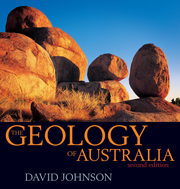Book contents
- Frontmatter
- Contents
- Map
- Preface
- Acknowledgements
- Map of main localities mentioned
- Abbreviations and units
- 1 An Australian perspective
- 2 The Earth: A geology primer
- 3 Building the core of Precambrian rocks
- 4 Warm times: Tropical corals and arid lands
- 5 Icehouse: Carboniferous and Permian glaciation
- 6 Mesozoic warming: The great inland plains and seas
- 7 Birth of modern Australia: Flowering plants, mammals and deserts
- 8 The history and evolution of life on Earth
- 9 Eastern highlands and volcanoes barely extinct
- 10 Building the continental shelf and coastlines
- 11 Great Barrier Reef
- 12 Planets, moons, meteorites and impact craters
- 13 A geological perspective on climate change
- 14 Cycles in a continental journey
- Sources and references
- Figure sources
- Index
1 - An Australian perspective
Published online by Cambridge University Press: 05 August 2013
- Frontmatter
- Contents
- Map
- Preface
- Acknowledgements
- Map of main localities mentioned
- Abbreviations and units
- 1 An Australian perspective
- 2 The Earth: A geology primer
- 3 Building the core of Precambrian rocks
- 4 Warm times: Tropical corals and arid lands
- 5 Icehouse: Carboniferous and Permian glaciation
- 6 Mesozoic warming: The great inland plains and seas
- 7 Birth of modern Australia: Flowering plants, mammals and deserts
- 8 The history and evolution of life on Earth
- 9 Eastern highlands and volcanoes barely extinct
- 10 Building the continental shelf and coastlines
- 11 Great Barrier Reef
- 12 Planets, moons, meteorites and impact craters
- 13 A geological perspective on climate change
- 14 Cycles in a continental journey
- Sources and references
- Figure sources
- Index
Summary
Australia – a continent of great age, stability, aridity and flatness.
Radiometric dating is one of the keys to reading the story in the stones.
How has deep sea and space exploration changed our perspective on the Earth and Australia?
AUSTRALIA: AGE, STABILITY, CLIMATE, MAIN FEATURES
Some call Australia the world's largest island, others the smallest continent. I want to describe Australia as a continent, one of the primary building blocks of planet Earth, and one which spans almost the entire record of Earth history.
Traditional stories of the Aboriginal people tell of the creation of this continent, and of many of its landscape features. These stories are a parallel to this book because they emphasise the close spiritual relationship between all of us and the land that supports us.
This book tells how the rocks formed, and how the present climate developed over millions of years. As the Reverend J. Milne Curran wrote in one of the earliest explanations of Australian geology, in 1898:
Australia has a history far more ancient than any written by men – to read this history is one of the objects of geology – records preserved in the great stone-book of nature.
- Type
- Chapter
- Information
- The Geology of Australia , pp. 1 - 20Publisher: Cambridge University PressPrint publication year: 2009



